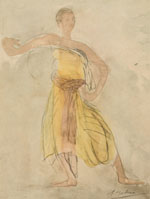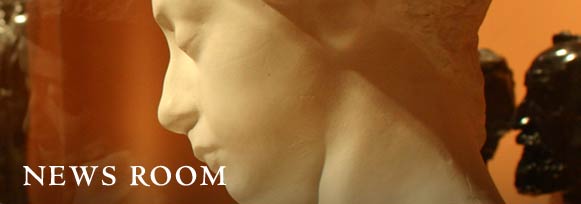Rodin and the Dancing Body
Installation and Performance Workshops at Cantor Arts Center
October 5, 2011 – January 1, 2012
Stanford, California — This fall, the Cantor Arts Center at Stanford University hosts “Rodin and the Dancing Body,” an installation and series of student performance workshops organized by Muriel Maffre, former principal dancer with the San Francisco Ballet and lecturer in Stanford’s Dance Division. Inspired by sculptor Auguste Rodin and his dance muse Isadora Duncan, “Rodin and the Dancing Body” probes the relationship between the dancing body and Rodin’s creation of movement and emotion in the static medium of cast bronze.
“Rodin and the Dancing Body” forms part of a new dance course offered by Maffre in the fall quarter 2011. Putting class activities on view at the Cantor Arts Center, Maffre and her students will explore such issues as the dialogue between dance and the visual arts and the meaning of the moving body in art exhibition spaces. As the dancers learn to become more aware of the actions of their own bodies, museum visitors are encouraged to reconsider their understanding of the dancing body. “Rodin and the Dancing Body” is on view concurrently with the Cantor Arts Center’s major exhibition “Rodin and America: Influence and Adaptation 1876–1936,” from Oct. 5, 2011 through Jan. 1, 2012.
The performance workshops take place in the Cantor Arts Center auditorium on Wednesdays, Oct. 12, 19 and 26 from 2:15 to 4:05 p.m. and on Thursdays, Nov. 3, 10 and
Dec. 1 from 6 to 8 p.m. The public can watch students working with LINES Contemporary Ballet director Alonzo King—in his first visit to Stanford—to develop choreography that references Rodin’s interest in movement and free-flowing gesture. The dancers will also learn passages from King’s “Without Wax” (1990), in which his choreography is informed by Rodin’s lost-wax casting technique. As part of the “Rodin and the Dancing Body” programming, visitors may sketch the dancers at work with materials to be provided by the Center. The final performance is set for Saturday, Dec. 3, 2 p.m. in Roble Gym, 375 Santa Teresa St. on the Stanford campus.
The installation in the Center’s Lynn Krywick Gibbons Gallery focuses on Isadora Duncan (1877–1927), a San Francisco native and one of the founders of modern dance, whose fluid, natural movements inspired the artists of her era to infuse their works with a sense of animation. Visitors will see archival footage of Duncan dancing, looped with a video montage of the original footage manipulated to include Maffre’s students re-enacting Duncan’s movements. In addition, the dancers will create gesture drawings in the gallery when the Center is closed to the public. Holding conte crayons as they dance, the students will trace their movements directly onto large sheets of paper affixed to the walls, which will remain on view for the duration of the installation.
“Rodin and the Dancing Body” is made possible by support from the Joan and John Jay Corley Fund.
# # #
VISITOR INFORMATION: Cantor Arts Center is open Wednesday – Sunday, 11 am - 5 pm, Thursday until 8 pm. Admission is free. The Center is located on the Stanford campus, off Palm Drive at Museum Way. Parking is free after 4 pm weekdays and all day on weekends. Information: 650-723-4177, museum.stanford.edu.
PUBLICITY PHOTOS: For high-resolution images, contact PR Assistant Manager, Margaret Whitehorn: 650-724-3600, mmwhite@stanford.edu
View related programs

Auguste Rodin, Cambodian Dancer, 1911. Colored collotype. From Camera Work, April/July, 1911. Philadelphia Museum of Art, Gift of Carl Zigrosser, 1966, 1966-205-34(7). Image © Philadelphia Museum of Art/Art Resource, NY.



